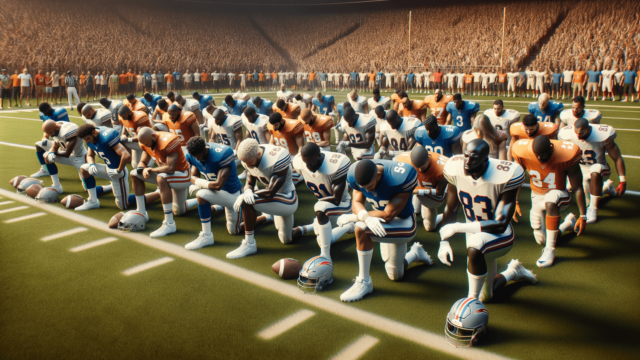
Football fans hold up shoes as a form of protest against poor performance or management decisions. It’s derived from the Middle Eastern custom of shoe-throwing as a strong insult, symbolizing discontent and disrespect. This act conveys the fans’ frustrations and their desire for change within their team.
The Meaning Behind Shoe Protests in Football
Football fans around the world have been known to hold up shoes during matches, an act that might be puzzling to some spectators. So, why do football fans hold up shoes during games? The answer lies in a form of protest, signaling the fans’ dissatisfaction with certain aspects of their team’s performance or management.
Cultural Origin of Shoe Protests
The act of holding up shoes or throwing them is deeply rooted in Middle Eastern culture, where throwing a shoe at someone signifies extreme insult and disrespect. By displaying their shoes, fans seek to express extreme discontent and demand change within their team, whether they feel the team’s performance is underwhelming or the club’s management is making poor decisions.
Examples of Shoe Protests in Football History
FC Barcelona vs Real Betis – 2015
During a 2015 La Liga match between FC Barcelona and Real Betis, Betis fans held up their shoes to protest against the club’s management for their poor handling of finances, resulting in a decline in the team’s performance. The act aimed to voice fans’ dissatisfaction and drive changes within the club’s management.
West Ham United vs Burnley – 2018
In 2018, a similar protest occurred during a Premier League match between West Ham United and Burnley. West Ham fans were unhappy about the overall state of the club (lack of investment, poor management, and disappointing performance), and some of them held up shoes during the match to signal their frustrations and demands for change.
Impact of Shoe Protests on Football Teams
While holding up shoes during a match may not directly result in the desired changes, it sends a powerful message to the club management and players. The protest highlights the importance of maintaining a strong connection between the fans and the team and the need to address the issues that led to the fans’ discontent. Whether or not the protest leads to immediate changes, it ensures that the fans’ voices are heard by the wider football community.
Other Forms of Fan Protests in Football
Beyond holding up shoes, football fans have adopted several forms of protest to express their dissatisfaction with their teams. These protests vary in nature but share a common goal: voicing disapproval and pushing for changes within the club. Some of these methods include boycotts, banners, pitch invasions, and social media campaigns.
Boycotts
Fans may choose to boycott games by not purchasing tickets or staying away from matches altogether. This form of protest impacts clubs financially, encouraging them to take fans’ concerns seriously and make necessary adjustments to address the problems identified by the supporters.
Banners and Signs
Another common form of protest is creating banners and signs with explicit messages expressing disapproval of the team’s performance, management, or other aspects of the club. These messages, often displayed during matches, can send a powerful signal to the club and attract media attention, thus amplifying the fans’ message.
Pitch Invasions
Pitch invasions involve fans storming the field to make their dissatisfaction known in a more disruptive and direct manner. While this mode of protest is generally discouraged due to safety concerns, it has occurred in several instances throughout football history, further illustrating the extent to which fans are willing to go to express their discontent.
Social Media Campaigns
With the advent of social media, fans now have a powerful platform to voice their opinions and rally other supporters behind their cause. By creating hashtags and setting up online campaigns, football fans can quickly spread their messages, pressure club management, and gain widespread support for their cause. Social media campaigns have proven increasingly effective in recent years, even leading to significant changes within some clubs.
FAQ: Common Questions About Football Fan Protests
After reading about football fans holding up shoes and other forms of protest, you may have some questions about the topic. Here’s a list of frequently asked questions and their concise answers to help you understand this fascinating aspect of football culture:
Do shoe protests lead to any real change within a club?
While shoe protests do not guarantee immediate or drastic changes within a club, they bring attention to the issues and demands of the fans. This pressure can lead clubs to address the fans’ concerns, but the impact of shoe protests varies depending on the specific situation and the club’s willingness to engage in constructive dialogue with their supporters.
Are football fan protests always disruptive?
No, not all football fan protests are disruptive. Although some forms of protest, like pitch invasions, can be disruptive or even dangerous, other protests such as boycotts or the displaying of banners typically do not cause major disruptions during a match. The key is for fans to voice their dissatisfaction while respecting the safety and enjoyment of all in attendance.
Do club management and players pay attention to these protests?
Yes, club management and players are generally aware of protests that take place during matches or online. These protests can influence decision-making within a club, demonstrate the importance of addressing fans’ concerns, and sometimes lead to dialogue between supporter groups and club management or representative bodies.
Do other sports have fan protests similar to football?
Yes, fan protests are not exclusive to football; they also occur in many other sports. Fans in other sports may use similar methods such as shoe protests, boycotts, displays of banners, or social media campaigns to express their dissatisfaction with certain aspects of their favorite teams or sports organizations.
Are shoe protests a form of hooliganism?
Shoe protests, while a strong form of condemnation, are generally not considered hooliganism unless they involve violent or destructive behavior. Most shoe protests are limited to the visual display of shoes in stadiums or other public domains, intended to send a clear message without causing physical harm or damage.
Featured Posts
- No pillar pages found.





